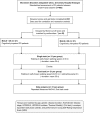Gait and Cognition in Parkinson's Disease: Cognitive Impairment Is Inadequately Reflected by Gait Performance during Dual Task
- PMID: 29123499
- PMCID: PMC5662548
- DOI: 10.3389/fneur.2017.00550
Gait and Cognition in Parkinson's Disease: Cognitive Impairment Is Inadequately Reflected by Gait Performance during Dual Task
Abstract
Introduction: Cognitive and gait deficits are common symptoms in Parkinson's disease (PD). Motor-cognitive dual tasks (DTs) are used to explore the interplay between gait and cognition. However, it is unclear if DT gait performance is indicative for cognitive impairment. Therefore, the aim of this study was to investigate if cognitive deficits are reflected by DT costs of spatiotemporal gait parameters.
Methods: Cognitive function, single task (ST) and DT gait performance were investigated in 67 PD patients. Cognition was assessed by the Montreal Cognitive Assessment (MoCA) followed by a standardized, sensor-based gait test and the identical gait test while subtracting serial 3's. Cognitive impairment was defined by a MoCA score <26. DT costs in gait parameters [(DT - ST)/ST × 100] were calculated as a measure of DT effect on gait. Correlation analysis was used to evaluate the association between MoCA performance and gait parameters. In a linear regression model, DT gait costs and clinical confounders (age, gender, disease duration, motor impairment, medication, and depression) were correlated to cognitive performance. In a subgroup analysis, we compared matched groups of cognitively impaired and unimpaired PD patients regarding differences in ST, DT, and DT gait costs.
Results: Correlation analysis revealed weak correlations between MoCA score and DT costs of gait parameters (r/rSp ≤ 0.3). DT costs of stride length, swing time variability, and maximum toe clearance (|r/rSp| > 0.2) were included in a regression analysis. The parameters only explain 8% of the cognitive variance. In combination with clinical confounders, regression analysis showed that these gait parameters explained 30% of MoCA performance. Group comparison revealed strong DT effects within both groups (large effect sizes), but significant between-group effects in DT gait costs were not observed.
Conclusion: These findings suggest that DT gait performance is not indicative for cognitive impairment in PD. DT effects on gait parameters were substantial in cognitively impaired and unimpaired patients, thereby potentially overlaying the effect of cognitive impairment on DT gait costs. Limits of the MoCA in detecting motor-function specific cognitive performance or variable individual response to the DT as influencing factors cannot be excluded. Therefore, DT gait parameters as marker for cognitive performance should be carefully interpreted in the clinical context.
Keywords: Montreal Cognitive Assessment; Parkinson’s disease; cognition; dual task; gait; gait analysis.
Figures



 and dual task ◼ condition (cognitively impaired, n = 21, and unimpaired Parkinson’s disease patients, n = 21). *Adapted significance level (αC) by Benjamini–Hochberg multiple testing correction (see Table 3).
and dual task ◼ condition (cognitively impaired, n = 21, and unimpaired Parkinson’s disease patients, n = 21). *Adapted significance level (αC) by Benjamini–Hochberg multiple testing correction (see Table 3).Similar articles
-
Fear of Falling Does Not Influence Dual-Task Gait Costs in People with Parkinson's Disease: A Cross-Sectional Study.Sensors (Basel). 2022 Mar 5;22(5):2029. doi: 10.3390/s22052029. Sensors (Basel). 2022. PMID: 35271176 Free PMC article.
-
Gait performance and non-motor symptoms burden during dual-task condition in Parkinson's disease.Neurol Sci. 2023 Jan;44(1):181-190. doi: 10.1007/s10072-022-06411-2. Epub 2022 Sep 20. Neurol Sci. 2023. PMID: 36125574
-
Associations of dual-task walking costs with cognition in Parkinson's disease.Gait Posture. 2024 May;110:48-52. doi: 10.1016/j.gaitpost.2024.03.002. Epub 2024 Mar 6. Gait Posture. 2024. PMID: 38484647
-
Comparing the effects of dual-task training and single-task training on walking, balance and cognitive functions in individuals with Parkinson's disease: A systematic review.Chin Med J (Engl). 2024 Jul 5;137(13):1535-1543. doi: 10.1097/CM9.0000000000002999. Epub 2024 May 8. Chin Med J (Engl). 2024. PMID: 38716704 Free PMC article.
-
Cognitive-motor dual-task interference in Alzheimer's disease, Parkinson's disease, and prodromal neurodegeneration: A scoping review.Gait Posture. 2023 Sep;105:58-74. doi: 10.1016/j.gaitpost.2023.07.277. Epub 2023 Jul 17. Gait Posture. 2023. PMID: 37487365 Free PMC article.
Cited by
-
Freezing of Gait in Parkinson's Disease: Implications for Dual-Task Walking.J Parkinsons Dis. 2023;13(6):1035-1046. doi: 10.3233/JPD-230063. J Parkinsons Dis. 2023. PMID: 37574744 Free PMC article.
-
Dual-Task Effects During a Motor-Cognitive Task in Parkinson's Disease: Patterns of Prioritization and the Influence of Cognitive Status.Neurorehabil Neural Repair. 2021 Apr;35(4):356-366. doi: 10.1177/1545968321999053. Epub 2021 Mar 10. Neurorehabil Neural Repair. 2021. PMID: 33719728 Free PMC article. Clinical Trial.
-
Stable Sparse Classifiers predict cognitive impairment from gait patterns.Front Psychol. 2022 Aug 16;13:894576. doi: 10.3389/fpsyg.2022.894576. eCollection 2022. Front Psychol. 2022. PMID: 36051195 Free PMC article.
-
Effects of motor-cognitive training on dual-task performance in people with Parkinson's disease: a systematic review and meta-analysis.J Neurol. 2023 Jun;270(6):2890-2907. doi: 10.1007/s00415-023-11610-8. Epub 2023 Feb 23. J Neurol. 2023. PMID: 36820916 Free PMC article.
-
The Effects of an Individualized Smartphone-Based Exercise Program on Self-defined Motor Tasks in Parkinson Disease: Pilot Interventional Study.JMIR Rehabil Assist Technol. 2022 Nov 15;9(4):e38994. doi: 10.2196/38994. JMIR Rehabil Assist Technol. 2022. PMID: 36378510 Free PMC article.
References
LinkOut - more resources
Full Text Sources
Other Literature Sources

